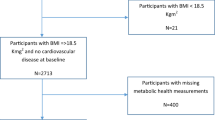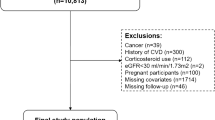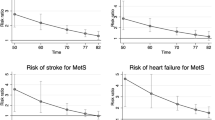Abstract
Objective:
The clinical importance of the metabolic syndrome (MeS) is confused by the existence of at least three different definitions proposed by prominent organizations, and by a lack of information about the prognostic value of diagnosing a person as having the syndrome by any of the definitions.
Design and subjects:
We used the US National Health and Nutrition Evaluation Survey (NHANES) to determine the prevalence in the United States of the variables used to define the MeS and cardiovascular disease (CVD), and to create a simulated population that matched the US population with respect to all the important characteristics, risk factors and treatments for CVD. We then used the Archimedes model to calculate the long-term CVD outcomes for each person in the simulated population.
Results:
The definitions implied an increased risk of CVD of 1.5–1.6. The definitions varied considerably in their ability to identify people at risk of myocardial infarctions (MIs); the proportion of people destined to have a future MI captured by the different definitions varied from 57 to 77%. The definitions also varied widely in how well they ruled out future MIs; failure to have MeS by a definition still left a chance of a future MI ranging from 23 to 42%. The definitions differed importantly in which people they identified as having MeS; 34% of those who met the ATP definition did not meet the WHO definition, 30% of those who met the WHO definition did not meet the ATP definition and 28% of those who met the IDF definition did not meet the ATP definition. Of the components of the definitions, the most important single factor for identifying a person at risk of future CVD was high glucose, with hypertension, obesity, high triglycerides and low HDL following in that order. High glucose, by itself, was as good as any definition of the MeS in predicting risk of future MI. Whichever definition was used, individuals who met the definition varied widely in their risk of CVD.
Conclusions:
For assessing a particular person's risk of future CVD and for making treatment decisions a diagnosis of MeS by any of the definitions added little if anything to assessing each person's risk factors.
This is a preview of subscription content, access via your institution
Access options
Subscribe to this journal
Receive 12 print issues and online access
$259.00 per year
only $21.58 per issue
Buy this article
- Purchase on Springer Link
- Instant access to full article PDF
Prices may be subject to local taxes which are calculated during checkout



Similar content being viewed by others
References
Third National Health and Nutrition Examination Survey (NHANES III). (1988–1994) CD ROM Series 11, no. 1 National Center for Health Statistics: Hyattsville MD, Available at http://www.cdc.gov/nchs/products/elec_prods/subject/nhanes3.htm).
Schlessinger L, Eddy DM . Archimedes: a new model for simulating health care systems: the mathematical formulation. J Biomed Inform 2002; 35: 37–50.
Eddy DM, Schlessinger L . Archimedes: a trial-validated model of diabetes. Diabetes Care 2003; 26: 3093–3101.
Schlessinger L, Eddy DM . Equations for the Archimedes model of diabetes and its complications. Technical Report, Parts A and B 2004.
Eddy DM, Schlessinger L . Validation of the Archimedes diabetes model. Diabetes Care 2003; 26: 3102–3110.
Expert Panel on Detection, Evaluation, and Treatment of High Blood Cholesterol in Adults. Executive summary of the third report of the national cholesterol education program (NCEP) expert panel on detection, evaluation, and treatment of high blood cholesterol in adults (Adult Treatment Panel III). JAMA 2001; 285: 2486–2497.
ATP III. website http://www.nhlbi.nih.gov/guidelines/cholesterol/atglance.htm#Step8 accessed on 15 September 2007.
World Health Organization. Definition, Diagnosis and Classification of Diabetes Mellitus and its Complications. Part 1: Diagnosis and Classification of Diabetes Mellitus. WHO Department of Noncommunicable Disease Surveillance: Geneva, 1999.
IDF. website http://www.idf.org/webdata/docs/IDF_Meta_def_final.pdf accessed on 15 September 2007.
Alexander CM, Landsman PB, Teutsch SM, Haffner SM . NCEP metabolic syndrome, diabetes mellitus and prevalence of coronary heart disease. Diabetes 2003; 52: 1210–1214.
Author information
Authors and Affiliations
Corresponding author
Rights and permissions
About this article
Cite this article
Eddy, D., Schlessinger, L. & Heikes, K. The metabolic syndrome and cardiovascular risk: implications for clinical practice. Int J Obes 32 (Suppl 2), S5–S10 (2008). https://doi.org/10.1038/ijo.2008.28
Published:
Issue Date:
DOI: https://doi.org/10.1038/ijo.2008.28
Keywords
This article is cited by
-
Comment on 'Association between serum osteocalcin and body mass index: a systematic review and meta-analysis.'
Endocrine (2017)
-
Challenges in sodium intake reduction and meal consumption patterns among participants with metabolic syndrome in a dietary trial
Nutrition Journal (2013)
-
Comparison of four definitions of the metabolic syndrome and odds of ischemic heart disease in the Lithuanian urban population
International Journal of Public Health (2012)
-
The metabolic syndrome: useful concept or clinical tool? Report of a WHO Expert Consultation
Diabetologia (2010)



